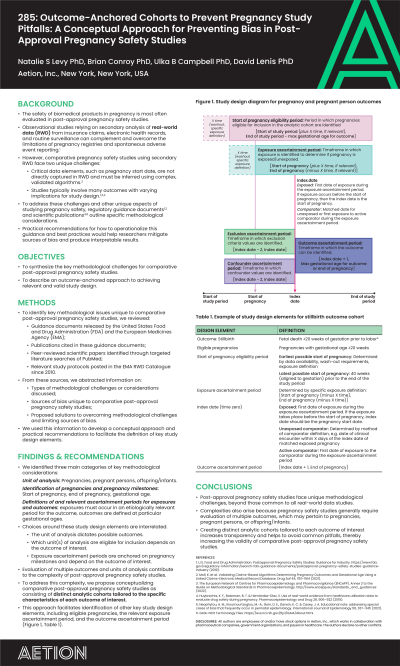Pregnancy and lactation
Session: Poster Session B
(285) Outcome-Anchored Cohorts to Prevent Pregnancy Study Pitfalls: A Conceptual Approach for Preventing Bias in Post-Approval Pregnancy Safety Studies
Tuesday, August 27, 2024
8:00 AM - 6:00 PM CEST
Location: Convention Hall II


Natalie Levy, PhD, MPH
Director
Aetion, Inc., United States- BC
Brian Conroy
Aetion, Inc., United States
- UC
Ulka Campbell, PhD, MPH
Aetion, Inc., United States
- DL
David Lenis, PhD
Aetion, Inc, Spain
Presenting Author(s)
Co-Author(s)
Background: Several regulatory guidances and scientific publications discuss methodological considerations unique to post-approval pregnancy safety studies conducted with real-world data. Operational recommendations for conceptualizing and designing post-approval pregnancy safety studies would help researchers address these challenges and avoid bias.
Objectives: To synthesize the key methodological challenges for post-approval pregnancy safety studies and to describe an outcome-anchored approach to designing relevant and valid post-approval pregnancy safety studies.
Methods: We reviewed posted protocols for post-approval pregnancy safety studies, guidance documents released by the United States Food and Drug Administration (FDA) and the European Medicines Agency (EMA), and peer-reviewed scientific publications to identify major themes around methodological considerations. Based on this review, we developed a conceptual approach and accompanying recommendations to facilitate the definition of key study design elements.
Results: From our review, we identified three categories of key methodological considerations: the unit of analysis, identification of pregnancies and pregnancy milestones (e.g., start of pregnancy, end of pregnancy, gestational age), and definitions of and ascertainment windows for the exposure and outcome. We propose conceptualizing these studies as consisting of distinct analytic cohorts tailored to the specific characteristics of each pregnancy and infant outcome of interest. This approach facilitates the identification of pregnancies eligible for inclusion, the relevant timeframe for outcome ascertainment, the etiologically relevant exposure window, the index date, and the relevant length of follow-up based on gestational age
Conclusions: Post-approval pregnancy safety studies face unique methodological challenges, beyond those common to all real-world evidence studies. Creating distinct analytic cohorts tailored to each outcome of interest simplifies their design and helps to avoid common sources of bias.
Objectives: To synthesize the key methodological challenges for post-approval pregnancy safety studies and to describe an outcome-anchored approach to designing relevant and valid post-approval pregnancy safety studies.
Methods: We reviewed posted protocols for post-approval pregnancy safety studies, guidance documents released by the United States Food and Drug Administration (FDA) and the European Medicines Agency (EMA), and peer-reviewed scientific publications to identify major themes around methodological considerations. Based on this review, we developed a conceptual approach and accompanying recommendations to facilitate the definition of key study design elements.
Results: From our review, we identified three categories of key methodological considerations: the unit of analysis, identification of pregnancies and pregnancy milestones (e.g., start of pregnancy, end of pregnancy, gestational age), and definitions of and ascertainment windows for the exposure and outcome. We propose conceptualizing these studies as consisting of distinct analytic cohorts tailored to the specific characteristics of each pregnancy and infant outcome of interest. This approach facilitates the identification of pregnancies eligible for inclusion, the relevant timeframe for outcome ascertainment, the etiologically relevant exposure window, the index date, and the relevant length of follow-up based on gestational age
Conclusions: Post-approval pregnancy safety studies face unique methodological challenges, beyond those common to all real-world evidence studies. Creating distinct analytic cohorts tailored to each outcome of interest simplifies their design and helps to avoid common sources of bias.
